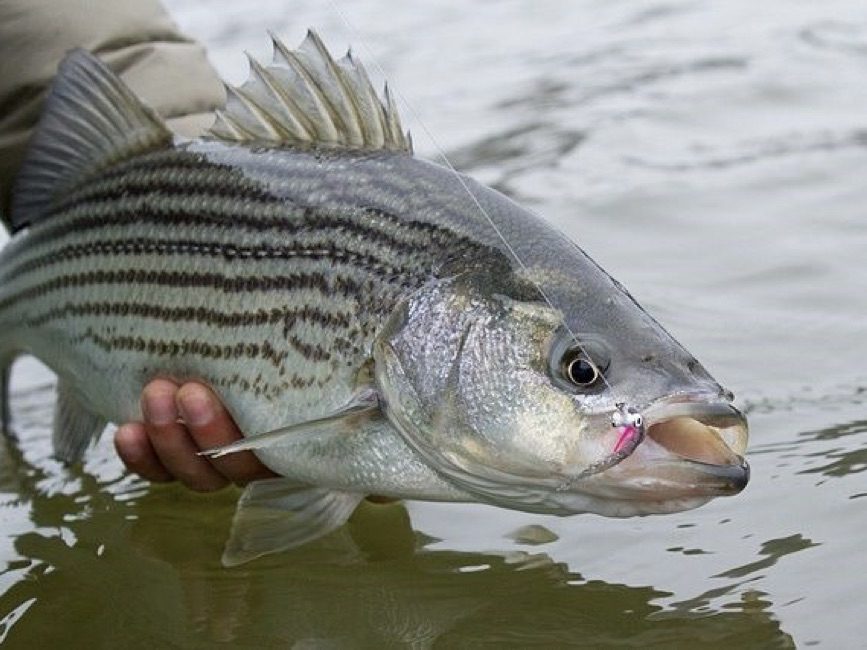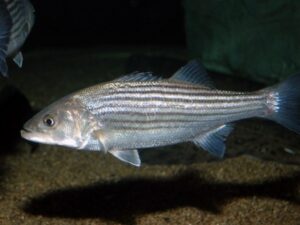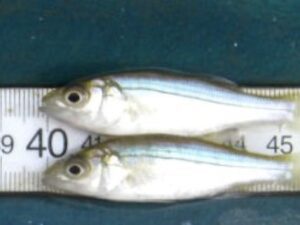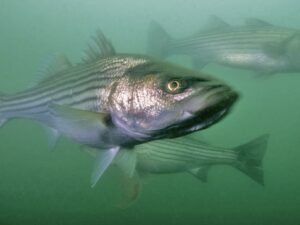Issue 5 | September 2022 |Maryland’s State Fish In Peril?!

By Bryan Kent Gomes, ClearShark H2O Education Coordinator
The striped bass, Maryland’s State Fish, is sometimes better known locally in our Bay’s watershed as a rockfish. It’s a nickname they’ve acquired because they spend much of their time over and around the oyster reefs or oyster “rocks” in the Chesapeake (spoiler alert – this is where the habitat and, therefore, the food is). The fish has other regional nicknames including “schoolies”, “cows”, and “linesiders”. And in New England, where George Gavutis Jr., US Fish and Wildlife Service retiree fly fishes for them, they are known as “stripers”.
It is (maybe more like “was”) an abundant fish throughout the Chesapeake Bay. This is because the  striped bass is anadromous, meaning it leaves the saltwater environment where it spends most of its adult life and travels upstream to fresher water portions of rivers to spawn each April. Rockfish return to the same rivers where they were spawned to reproduce as well. That’s quite a GPS they have hard-wired to their fish brains! Striped bass can grow up to five feet in length and can tip the scales up to 75 pounds. They live upwards of 25 years with males able to reproduce around two to four years and females able to reproduce around four to eight years.
striped bass is anadromous, meaning it leaves the saltwater environment where it spends most of its adult life and travels upstream to fresher water portions of rivers to spawn each April. Rockfish return to the same rivers where they were spawned to reproduce as well. That’s quite a GPS they have hard-wired to their fish brains! Striped bass can grow up to five feet in length and can tip the scales up to 75 pounds. They live upwards of 25 years with males able to reproduce around two to four years and females able to reproduce around four to eight years.
Stripers are a popular sport fish that are hard fighters and can be caught on all types of tackle and bait including spin rods, fly rods, bait rods, live and dead bait, plastic and metal lures. They can be caught via trolling (with planer boards and umbrella rigs), casting, bottom fishing, day or night, high or low tide. Striped bass are aggressive feeders and can be landed via piers, boats, or along shorelines, by both recreation and commercial anglers. They are a tasty panfish and easy to filet. They are a light tasting fish that rivals haddock and flounder.
All of the above reasons are factors in the rockfish’s declining numbers in the Chesapeake, as well as other areas. This fish is native to the coastal Atlantic states from Maine (also found in Canadian waters) to North Carolina. With the Northeast and Mid-Atlantic regions being the most populous part of the United States, this fish is under constant and intense pressure of being harvested as it moves up and down the Atlantic waterways which just so happens to parallel our busy I-95 corridor. According to NOAA (National Oceanic and Atmospheric Administration) data, striped bass are the number one species caught (by pounds) in the United States!
Young rockfish spend the first four to eight years of life in bays and rivers before moving out into the Atlantic Ocean as mature adult fish. According to the Chesapeake Bay Program, between 70-90 percent of the striped bass travel from the Atlantic Ocean into the Chesapeake Bay during the  spring spawn in April. Maryland state regulations were put in place with a timeline to allow mature fish to reach tidal fresh waters in the extremities of the Chesapeake Bay. Anglers are able to harvest these fish later in the season after they have made it to these freshwater tributaries. The current general state regulations allow one fish per person with a minimum size of 35 inches in the first two weeks of May. For the last two weeks of May through most of the rest of the calendar year, it is one fish per person with a minimum size of 19 inches. For all the regulations for striped bass in the Chesapeake, click here.
spring spawn in April. Maryland state regulations were put in place with a timeline to allow mature fish to reach tidal fresh waters in the extremities of the Chesapeake Bay. Anglers are able to harvest these fish later in the season after they have made it to these freshwater tributaries. The current general state regulations allow one fish per person with a minimum size of 35 inches in the first two weeks of May. For the last two weeks of May through most of the rest of the calendar year, it is one fish per person with a minimum size of 19 inches. For all the regulations for striped bass in the Chesapeake, click here.
This is where it gets murky. The larger the fish, the higher the percentage of toxins in their biomass including pesticides, PCBs (industrial chemicals), and heavy metals such as mercury. Also, the larger the fish, the more likely it is of spawning and spawning in larger quantities. States like Maine and Maryland have previously had slot limits for harvesting rockfish. A slot limit means instead of harvesting a fish over a certain length (say 30 inches), fish caught that are in a size range (say 20-26 inches) can be harvested. This may seem counterintuitive to some anglers wanting the biggest “trophy” fish for a photo op and to have a larger filet for the dinner table. But these are the fish we need to protect the most. Plus, the smaller slot range fish are more abundant, not spawning as much and the safest to eat.
Over the last few years, the coast wide assessment of this fish is showing declining spawning success in the Mid-Atlantic and increasing spawning success in Canadian waters. This can be attributed to climate change. With waters around the world, although ever so slight, increasing in temperature over the last 20 plus years, the adult migratory fish that used to come into the Chesapeake and Delaware Bays are now hanging around the waters from New Jersey to points north. Twenty years ago, the wintering population of this species was was concentrated around southern Virginia.
Another factor local to the Chesapeake region is that, for more than a decade, perpetual dead zones – excess nutrients in the water that create algal blooms that when they die, extract the dissolved oxygen from areas of the waterway – have killed the bottom habitat that fish prefer throughout the southern portions of the Chesapeake. And this region of the Bay is the “gateway” for all the incoming fish – no food, no fish! Another issue is the cyclical flux of spawning years. Like oysters and blue crabs, rockfish have good and bad recruitment/spawn years.
David Sikorski, Executive Director of Coastal Conservation Association (CCA) Maryland, said “Simply put, striped bass catches are too high for the recent levels of  reproduction that have been observed in the Chesapeake Bay. While many try to point to one source of mortality that is driving recent trends, coast wide mortality is made up of fish caught in recreational and commercial fisheries, so all must be willing to reduce their impact if we stand a chance to turn this fishery around. Only by managing for what is best for the resource first can we hope for another successful story in rebuilding striped bass populations”. Sikorski also serves as one of Maryland’s three members of the Striped Bass Management Board through the Atlantic States Marine Fisheries Commission.
reproduction that have been observed in the Chesapeake Bay. While many try to point to one source of mortality that is driving recent trends, coast wide mortality is made up of fish caught in recreational and commercial fisheries, so all must be willing to reduce their impact if we stand a chance to turn this fishery around. Only by managing for what is best for the resource first can we hope for another successful story in rebuilding striped bass populations”. Sikorski also serves as one of Maryland’s three members of the Striped Bass Management Board through the Atlantic States Marine Fisheries Commission.
What can you do? Follow the regulations in your state and how they change for the time of year. They are very important to protect the proliferation of the species. And be a good steward of the LAND to ensure a better local waterway. These animals’ food and habitat are greatly influenced by our practices on land and how/what we do in our day to day. With new data coming out showing more fishing mortality than current spawning trends, expect some new rules and regulations to go into effect in the near future.

